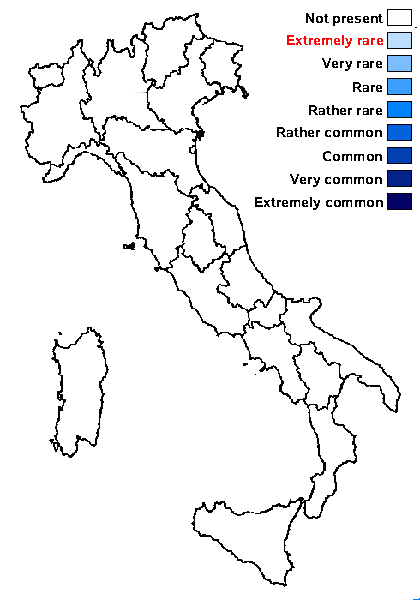Lichinella heppii (Müll. Arg.) P. Clerc & Cl. Roux
in Clerc, Cryptogamica Helvetica, 19: 292, 2004. Basionym: Omphalaria heppii Müll. Arg. - Mém. Soc. Phys. Hist. Nat. Genève, 16: 422, 1862.
Synonyms: Gonohymenia heppii (Müll. Arg.) Henssen; Thyrea heppii (Müll. Arg.) Lettau
Distribution: N - VG (TSB 2296).
Description: Thallus squamulose-umbilicate to subfoliose-umbilicate, gelatinous when wet, blackish or grey-pruinose, the squamules 5-20 mm wide, 110-225 µm thick, flattened, forming rosettes or cushions, distinctly lobulate with loosely adpressed (in central parts) to ascending (in marginal parts) lobules, the surface with small, globose, isidia-like outgrowths, the tips rounded, with down-turned margins; lower surface attached by a central holdfast. Thallus ecorticate, 110-225 μm thick, the central part occupied by a 50-175 μm thick, loose hyphal strand without photobionts. Apothecia thallinocarps, hemiangiocarpous, the ascogonia arising freely beneath the thallus surface, marginal to submarginal, appearing as round to irregularly shaped, flat to convex, brown swellings best visible in the wet state. Proper exciple absent or very thin; epithecium brownish; hymenium colourless, finally separated into partial hymenia by intrusions of wedge-shaped, sterile thalline tissue, covered by a continuous layer of sterile tissue separated only by the pore-like discs of the partial hymenia, K/I+ blue turning wine-red. Asci 16-32-spored, subcylindrical to obclavate, prototunicate, with a thin, one-layered, non-amyloid wall, an amyloid external apical cap, and passive spore discharge via apical rupturing, Lichina-type. Ascospores 1-celled, hyaline, broadly ellipsoid, 5-9 x 3-5 μm. Photobiont cyanobacterial, chroococcoid, with a few cells penetrated by haustoria and surrounded by a brownish gelatinous sheath. Spot tests: all negative. Chemistry: without lichen substances. Note: a critical taxon, purported to be most frequent in humid stands by rivers. The type is from France: "sandstone boulders along the Arve near Mornex". The only Italian record needs confirmation. An earlier record from Emilia (see Nimis 1993: 422) proved to be wrong.
Growth form: Foliose, umbilicate
Substrata: rocks
Photobiont: cyanobacteria, coccaceous (e.g. Gloeocapsa)
Reproductive strategy: mainly sexual
Poorly known taxon in need of further study
Commonnes-rarity: (info)
Alpine belt: absent
Subalpine belt: absent
Oromediterranean belt: absent
Montane belt: absent
Submediterranean belt: rare
Padanian area: absent
Humid submediterranean belt: absent
Humid mediterranean belt: absent
Dry mediterranean belt: absent

Predictive model
Herbarium samples
Growth form: Foliose, umbilicate
Substrata: rocks
Photobiont: cyanobacteria, coccaceous (e.g. Gloeocapsa)
Reproductive strategy: mainly sexual
Poorly known taxon in need of further study
Commonnes-rarity: (info)
Alpine belt: absent
Subalpine belt: absent
Oromediterranean belt: absent
Montane belt: absent
Submediterranean belt: rare
Padanian area: absent
Humid submediterranean belt: absent
Humid mediterranean belt: absent
Dry mediterranean belt: absent

Predictive model
| Herbarium samples |
 INDEX FUNGORUM
INDEX FUNGORUM
 GBIF
GBIF

